- Last Updated: January 15th, 2026
Key Takeaways
Insurance companies may deny or limit coverage for PCB cleanup, leading to disputes over who is responsible for paying the costs of remediation.
PCB cleanup projects can encounter unexpected challenges that increase costs and require change orders.
Obtaining financing for PCB cleanup can be difficult due to the high costs and potential liability involved.
Overview of PCB Cleanup Disputes
On this page, we’ll discuss an overview of PCB cleanup disputes, financial and insurance issues related to PCB cleanup, legal strategies for resolving PCB cleanup conflicts, and much more.
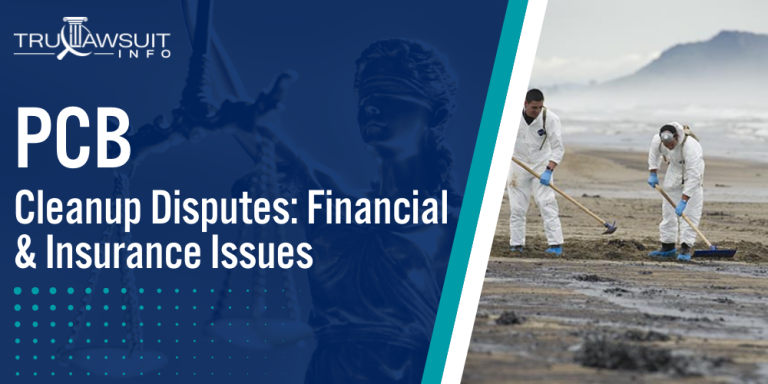
Intro To PCB Cleanup Disputes
PCB cleanup projects often involve financial and insurance issues that can lead to disputes between property owners, contractors, and insurers.
Here are some common financial and insurance issues that arise in PCB cleanup disputes:
- Disagreements over the scope and cost of the cleanup work
- Disputes over insurance coverage for PCB contamination and remediation
- Conflicts between property owners and contractors regarding payment and performance
- Challenges in obtaining financing for PCB cleanup projects
If you are involved in a PCB cleanup dispute, it’s important to seek legal guidance from experienced environmental attorneys who can help protect your rights and interests.
Contact TruLawsuit Info using the chat on this page to receive an instance case evaluation to learn more about your legal options for resolving PCB cleanup disputes.
Regulatory Advice on Insurance Claims for PCB Cleanup Costs
Understanding insurance coverage and the legal landscape is essential when dealing with PCB cleanup costs.
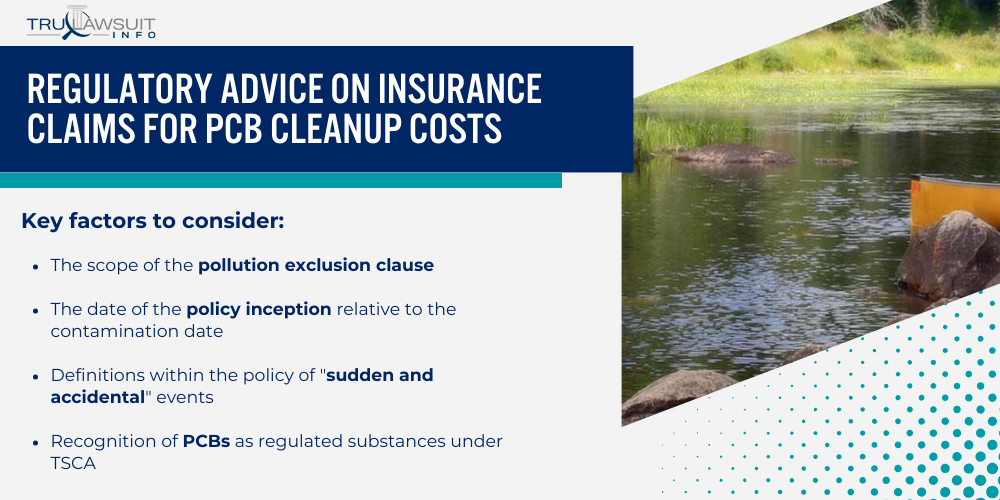
This section offers guidance on navigating those waters with precision.
Insurance Coverage Under TSCA for PCB Cleanup Operations
Under the Toxic Substances Control Act (TSCA), insurers may provide coverage for PCB cleanup.
Coverage frequently hinges on the specifics outlined within the policy.
Key factors to consider:
- The scope of the pollution exclusion clause
- The date of the policy inception relative to the contamination date
- Definitions within the policy of “sudden and accidental” events
- Recognition of PCBs as regulated substances under TSCA
Advanced research should be conducted regarding TSCA regulations for specific details on insurance claims.
Challenges of a Property Transfer During PCB Cleanup Lawsuit
Several legal and insurance challenges can arise when a property undergoing PCB cleanup becomes subject to a transfer or sale.
Issues typically include:
- Determining the liable party for cleanup costs
- Disclosures relating to the extent of PCB contamination
- Implications of ongoing litigation on property value
- Insurance claim transfers or new policies needed for the new property owner
Each case often presents its own set of details, which should be carefully reviewed with respect to current EPA guidelines.
FAST: Aiding in Insurance Claims for PCB Cleanup Approval
The Facilitating Administration of Superfund Treatment (FAST) may assist stakeholders in swiftly approving insurance claims related to PCB cleanups.
The program emphasizes:
- Reducing the bureaucratic burden
- Streamlining the EPA approval process
- Transparency in communications
- Engaging stakeholders in a collaborative process
One should investigate the FAST program’s specific offerings to understand better the assistance it provides in insurance claim processing.
Financial Planning for Site Characterization in PCB Cleanup
Effective financial planning for site characterization is pivotal for managing costs and aligning with regulatory compliance in PCB cleanup operations.
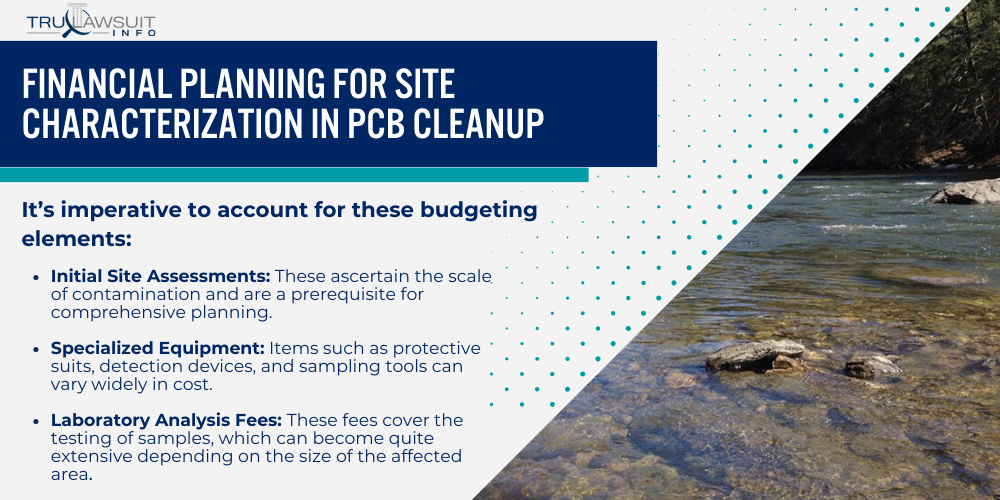
This involves meticulous budgeting for site evaluation, including potential costs in the cleanup plan, and ensuring proper insurance documentation for certification.
Budgeting for Site Evaluations Pre-PCB Cleanup
Botched financial preparations can seriously jeopardize the foundation of a PCB cleanup project.
It’s imperative to account for these budgeting elements:
- Initial Site Assessments: These ascertain the scale of contamination and are a prerequisite for comprehensive planning.
- Specialized Equipment: Items such as protective suits, detection devices, and sampling tools can vary widely in cost.
- Laboratory Analysis Fees: These fees cover the testing of samples, which can become quite extensive depending on the size of the affected area.
- Potential Additional Studies: Unexpected complexities, such as uncovering opioid addiction treatment facilities as affected sites, may require specialized evaluations.
Financial Aspects of a PCB Cleanup Plan
The cleanup plan must encapsulate a range of financial considerations to ensure the operation proceeds smoothly.
Before proceeding, it’s essential to:
- Estimate Remediation Costs: Including the expenses for materials, labor, and electrical equipment required for mopping up PCBs.
- Environmental Impact Assessment: Anticipating the cost of studies to evaluate effects on both human health, potentially including dental health issues, and ecosystems.
- Contingency Fund: Allocating a reserve budget to address unforeseen challenges or delays.
- Long-term Monitoring: The cost of ongoing assessment of the site post-cleanup completion notification should be considered to ensure PCB levels remain within acceptable limits.
Insurance Documentation for PCB Cleanup Certification
Insurance is a critical component for demonstrating financial capability and liability coverage.
It plays a role in:
- Proof of Financial Assurance: To confirm that sufficient funds are dedicated to the entire cleanup, from start to finish.
- Liability Coverage: Policies that protect against possible claims related to PCB exposure or damage to third parties.
- Compliance Documentation: Required by regulatory bodies to illustrate that the entity undertaking the cleanup is prepared to cover all associated costs.
- Certification Records: Official documentation of the cleanup process for future audits.
Incorporating comprehensive financial planning and insurance considerations ensures that PCB cleanup initiatives are both effective and compliant with pertinent regulations on PCB waste management.
Financial Approaches to Insurance in PCB Cleanup Methodologies
In managing the financial risks associated with PCB cleanup, stakeholders have to balance between self-funded approaches and filing insurance claims.
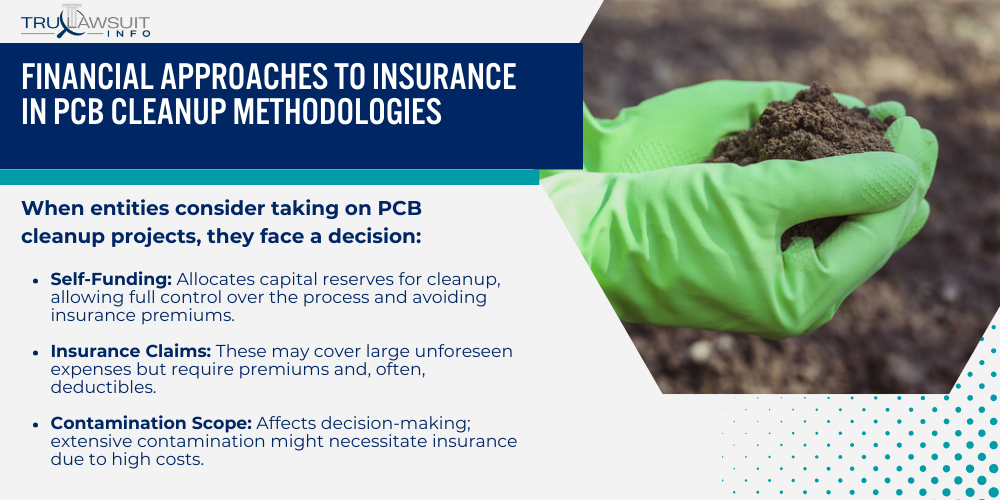
Evaluating the right insurance coverage for the job and assessing the inherent risks are vital steps in this process.
Self-Funded PCB Cleanup Versus Insurance Claims
The financial implications of PCB cleanup depend heavily on whether you choose to self-fund the project or utilize insurance.
Self-funding offers greater control and potentially faster turnaround, while insurance can provide a financial safety net for extensive contamination.
When entities consider taking on PCB cleanup projects, they face a decision:
- Self-Funding: Allocates capital reserves for cleanup, allowing full control over the process and avoiding insurance premiums.
- Insurance Claims: These may cover large unforeseen expenses but require premiums and, often, deductibles.
- Contamination Scope: Affects decision-making; extensive contamination might necessitate insurance due to high costs.
- Time Factor: Self-funding is quicker, avoiding claims processing delays.
Key factors to weigh include control over cleanup methods, financial flexibility, and speed of response.
Evaluating Insurance for Performance-Based PCB Cleanup
Companies often require assurance that PCB cleanup methodologies will achieve environmental safety before releasing funds.
Consideration must be made towards regulatory compliance:
- Environmental Regulations: Cleanup must meet standards, often found in sources like the EPA’s regulatory changes.
- Performance Clauses: Ensure that the cleanup method attains specified benchmarks before full payment.
- Premiums Versus Potential Savings: Weighing the cost of premiums against potential savings from an insurance coverage is essential.
- Claim History: Insurers consider past claims, affecting future premiums and terms.
Lead-in: Consideration must be made towards regulatory compliance, balancing costs and savings, and the influence of claim history.
Risk Assessment for Insurance Coverage of PCB Cleanup
Risk assessment is pivotal in determining the level and extent of insurance coverage for PCB cleanup efforts.
The risk matrix for PCB cleanup insurance should factor in the following key considerations:
- Likelihood of Occurrence: The probability that a cleanup project will encounter issues that could significantly increase costs.
- Severity Assessment: Potential financial impact of worst-case scenarios.
- Coverage Scope: Insurance should cover a range of PCB cleanup scenarios and costs found within the PCB cleanup and disposal regulations.
- Exclusions: Understanding what is not covered is as important as knowing what is.
Lead-in: The risk matrix for PCB cleanup insurance should factor in likelihood, impact, coverage scope, and exclusions.
Insurance Policies on Disposal and Management in PCB Cleanup
Proper insurance is essential in managing the financial risks associated with PCB cleanup, especially when dealing with high-temperature disposal and alternative methods.
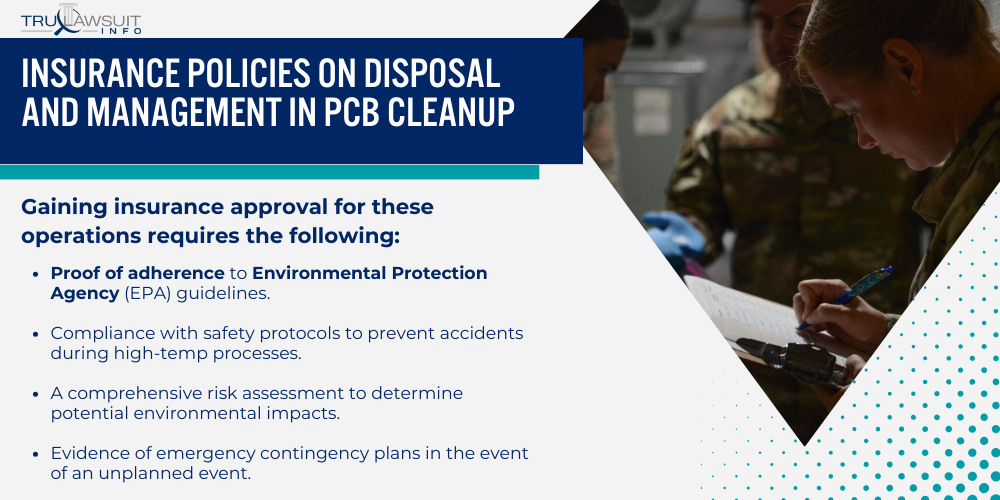
Insurance for landfills accepting PCB waste and for facilities approved for PCB cleanup must be carefully coordinated.
Gaining Insurance Approval for High-Temp PCB Cleanup Disposal
High-temperature incineration is a preferred method for the disposal of PCBs, as it destroys the contaminants effectively.
Gaining insurance approval for these operations requires the following:
- Proof of adherence to Environmental Protection Agency (EPA) guidelines.
- Compliance with safety protocols to prevent accidents during high-temp processes.
- A comprehensive risk assessment to determine potential environmental impacts.
- Evidence of emergency contingency plans in the event of an unplanned event.
Firms must ensure these due diligence steps are taken before seeking insurance coverage.
Insurance for Alternative PCB Cleanup Disposal Methods
Alternative disposal methods, such as chemical dechlorination, also need specific insurance policies to cover any associated risks.
This includes:
- Validation that the alternative methods are EPA-approved.
- Documentation showing the efficacy and safety of the cleanup and disposal obligations.
- An environmental impact statement detailing how these methods affect the local ecology.
- Proof of employee training and certifications in handling alternative cleanup operations.
Insurance companies will assess these factors carefully before issuing a policy.
Chemical Landfill Insurance Claims for PCB Cleanup Waste
When PCB waste is destined for a chemical waste landfill, the associated insurance claims focus on long-term liability.
Key considerations include:
- Longevity of the landfill’s integrity and contaminant containment abilities.
- Monitoring and maintenance plans for post-closure periods.
- The Hazardous waste landfill permitted compliance with Title 40 CFR part 761 regulation.
- History of violations or incidents related to PCB waste by the landfill operator.
These points are evaluated to determine the insurance claim’s validity and coverage limits.
Insurance Coordination for Approved PCB Cleanup Facilities
Insurance for PCB cleanup facilities covers a range of risks.
They must coordinate insurance coverage that includes:
- Third-party liability for any potential harm caused to neighboring properties or communities.
- Coverage for worker safety and health concerns, including dental health or oral infections potentially impacted by exposure to PCBs.
- Policies covering equipment failure or business interruption.
- Direct costs associated with regulatory compliance, including disposal and transport.
Facilities must work closely with insurers to ensure all aspects of their operations are adequately covered.
Insurance Applications for Risk-Based PCB Cleanup Approval
When applying for risk-based PCB cleanup approval from the Environmental Protection Agency (EPA), it’s essential to consider insurance requirements and their implications on the application process.
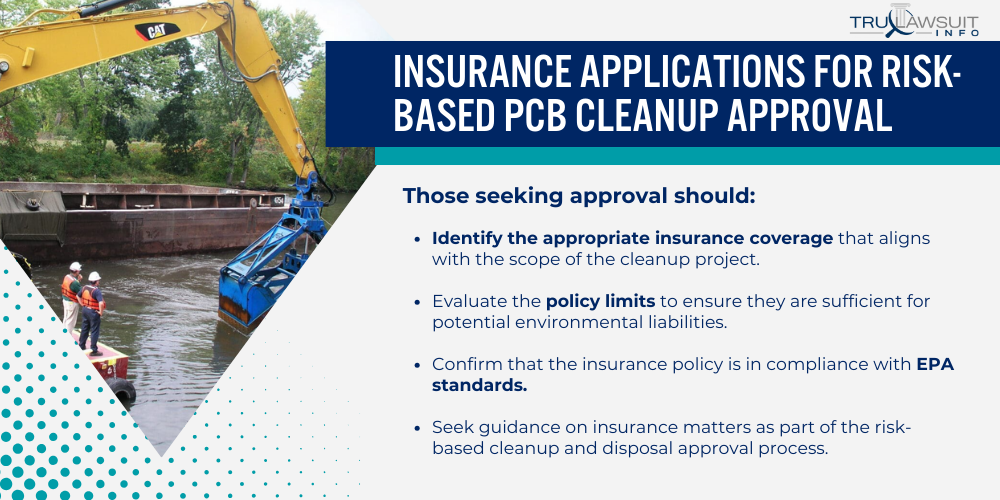
Navigating Insurance in the PCB Cleanup Application Process
Insurance plays a pivotal role in obtaining approval for PCB cleanup endeavors.
Those seeking approval should:
- Identify the appropriate insurance coverage that aligns with the scope of the cleanup project.
- Evaluate the policy limits to ensure they are sufficient for potential environmental liabilities.
- Confirm that the insurance policy is in compliance with EPA standards.
- Seek guidance on insurance matters as part of the risk-based cleanup and disposal approval process.
Deciphering Insurance Aspects of EPA Decisions on PCB Cleanup
The EPA’s decisions on PCB cleanup often hinge on insurability aspects.
To comprehend this component:
- Evaluate how insurance requirements impact the EPA’s approval process.
- Understand the insurance indemnification needed to proceed with cleanup activities.
- Recognize the role of insurance in managing post-cleanup liabilities.
- Consider the timeframe for coverage, ensuring that it protects both current and future concerns regarding the cleanup site.
Insurance Considerations in PCB Cleanup After Emergencies
When an emergency involves polychlorinated biphenyls (PCBs), understanding insurance coverage is essential for efficient response and recovery.
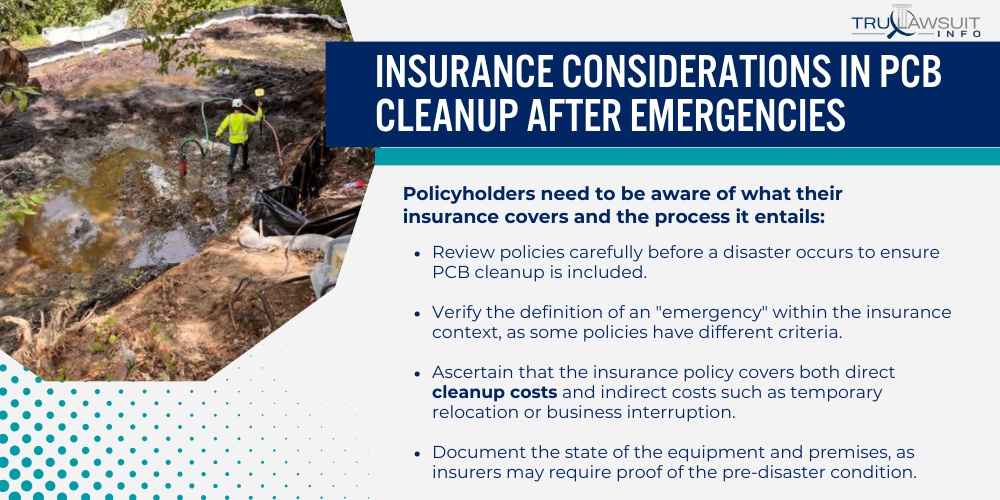
Planning for Insurance Coverage of PCB Cleanup After Disasters
Insurance coverage for PCB cleanup is a critical factor that should be addressed during disaster preparedness.
Policyholders need to be aware of what their insurance covers and the process it entails:
- Review policies carefully before a disaster occurs to ensure PCB cleanup is included.
- Verify the definition of an “emergency” within the insurance context, as some policies have different criteria.
- Ascertain that the insurance policy covers both direct cleanup costs and indirect costs such as temporary relocation or business interruption.
- Document the state of the equipment and premises, as insurers may require proof of the pre-disaster condition.
Utilizing resources like the EPA’s guidelines can provide additional insights into managing PCB remediation effectively.
Insurance Claims for PCB-Equipment Damage in Emergency Cleanup
Filing insurance claims for equipment damage due to PCB contamination must be approached with diligence.
Here’s a brief guide on handling claims:
- Notify the insurance company promptly after discovering PCB-related damage.
- Document all damage extensively and collect evidence such as photographs and PCB concentration reports.
- Work with a certified PCB remediation contractor to obtain detailed estimates for cleaning or replacement costs.
- Maintain a log of all correspondence and decisions made by the insurance provider during the claim process.
In situations involving PCB contamination, reference the EPA’s regulations, like those found in 40 CFR section 761.61, for pertinent cleanup requirements that may affect the claims process.
Insurance Disputes and Penalties in PCB Cleanup Non-Compliance
Enforcing PCB cleanup and disposal regulations can lead to financial repercussions and legal battles if entities fail to comply.
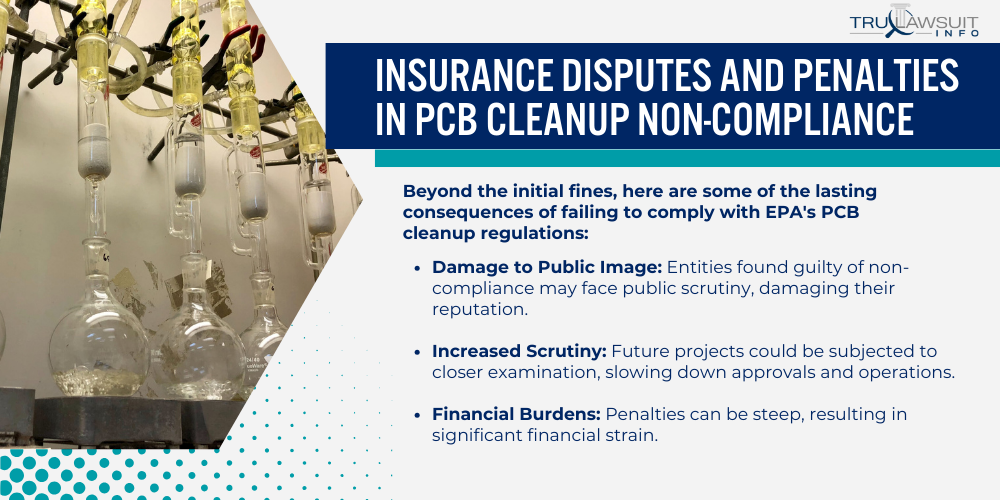
This section delves into the nuances of penalties and the role of insurance in the context of non-compliance with EPA regulations.
Future Implications of the EPA’s PCB Cleanup Penalties
The Environmental Protection Agency (EPA) has a structured system for imposing penalties on those who do not adhere to the PCB cleanup directives.
These repercussions are more than just immediate fines; they can have lasting effects on an entity’s operational credibility and financial health.
Beyond the initial fines, here are some of the lasting consequences of failing to comply with EPA’s PCB cleanup regulations:
- Damage to Public Image: Entities found guilty of non-compliance may face public scrutiny, damaging their reputation.
- Increased Scrutiny: Future projects could be subjected to closer examination, slowing down approvals and operations.
- Financial Burdens: Penalties can be steep, resulting in significant financial strain.
- Legal Complications: Non-compliance can lead to prolonged legal battles with the EPA and other government bodies.
To discourage violations and ensure uniform enforcement, the EPA has implemented a penalty policy in line with the Toxic Substances Control Act (TSCA).
Insurance Factors in Fair PCB Cleanup Penalty Assessments
The role of insurance in PCB cleanup scenarios is to provide financial coverage for the liabilities associated with the remediation process.
Insurance coverage for PCB cleanup can be complex, especially when it comes to penalties associated with non-compliance.
Here’s why:
- Compliance with PCB Regulations: Insurance may not cover penalties for non-compliance, putting the financial burden back on the entity.
- Coverage Scope: Policies differ regarding what is covered regarding environmental cleanup and associated legal fees.
- Claim Disputes: Insurers may challenge claims if they believe the entity knowingly violated regulations.
- Policy Terms: Specific terms and exemptions may restrict coverage in the event of non-compliance.
Entities should thoroughly understand their insurance policies to gauge the extent of coverage in instances of non-compliance.
It is crucial to have effective risk management strategies and to assess compliance to mitigate potential disputes with insurance providers regularly.
Insurance Benefits in Addressing PCB Cleanup and Disposal
Incorporating insurance in PCB cleanup and disposal projects plays an instrumental role in financial risk management and ensuring adherence to regulatory standards.
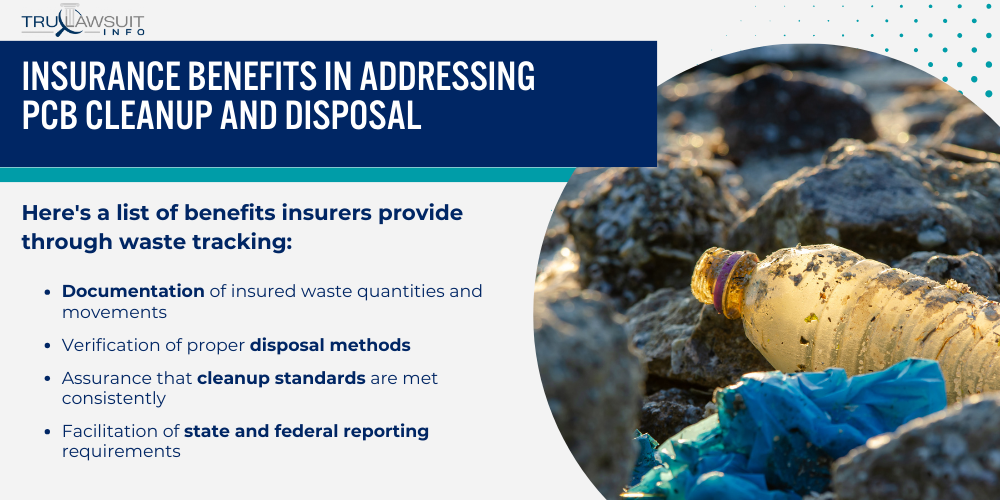
Tracking Insured PCB Waste in Cleanup Efforts
Insurance companies that cover PCB cleanup efforts often require detailed reports on the flow of contaminated materials.
This can be a powerful tool in maintaining transparency and accountability.
Here’s a list of benefits insurers provide through waste tracking:
- Documentation of insured waste quantities and movements
- Verification of proper disposal methods
- Assurance that cleanup standards are met consistently
- Facilitation of state and federal reporting requirements
The Role of Insurance in Comprehensive PCB Cleanup
By leveraging comprehensive coverage plans, insurance can serve as a critical support system for entities engaged in expensive PCB remediation activities.
Insurers contribute to cleanup projects by:
- Providing financial backing for cleanups at contaminated sites
- Covering costs associated with environmental assessments and testing
- Incentivizing policyholders with risk management advice
- Assisting in legal compliance with applicable PCB regulations
Insurance Incentives for Greener PCB Cleanup Practices
In the face of rising eco-consciousness, insurance providers increasingly promote environmentally friendly PCB remediation practices through various incentives.
This is reflected in the following ways:
- Rewarding policyholders who employ greener cleanup technologies
- Offering premium discounts for reduced environmental impact
- Encouraging the use of sustainable materials in remediation
- Supporting innovations that minimize secondary pollution
It should be noted that while insurance plays a supportive role in PCB cleanup efforts, the responsibility for addressing polychlorinated biphenyls remains with the entities producing or handling these substances.
Frequently Asked Questions
-
The recommended procedure for addressing a PCB spill involves immediate containment to prevent spread, followed by cleanup and disposal in accordance with EPA guidelines.
Methods vary based on spill size and location but may include physical removal, chemical decontamination, or thermal destruction.
-
Current EPA guidelines for PCB cleanup prioritize public health and environmental safety.
They suggest a systematic approach involving bulk PCB remediation waste management, encompassing safe packaging, transportation, and disposal of PCB-contaminated materials to licensed facilities.
-
Under environmental regulations, materials contaminated with PCBs due to spills, leaks, or other releases are classified as PCB remediation waste.
This category includes contaminated soil, sediments, and building materials with PCB concentrations at specific levels.
-
The EPA establishes accepted standards and thresholds for PCB decontamination and mainly revolves around concentration levels.
For instance, a concentration of greater than or equal to 50 ppm of PCBs in a substance requires specialized handling and disposal procedures.
-
Effective methods for reducing PCB contamination include physically removing contaminated soil or sediments, chemical methods like soil washing, and thermal treatments like incineration.
Bioremediation, which uses microorganisms to degrade PCBs, is an emerging field showing promise.
-
The EPA strictly regulates the disposal of PCBs through specific rules and guidelines outlined in the Toxic Substances Control Act (TSCA).
These regulations ensure that PCBs are disposed of in a manner that prevents environmental contamination and protects human health.
Each of these procedures and guidelines is an integral part of managing and reducing PCB contamination effectively.

Attorney Jessie Paluch, founder of TruLawsuit Info, has over 25 years of experience as a personal injury and mass tort attorney, and previously worked as an international tax attorney at Deloitte. Jessie collaborates with attorneys nationwide — enabling her to share reliable, up-to-date legal information with our readers.
Legally Reviewed
This article has been written and reviewed for legal accuracy and clarity by the team of writers and legal experts at TruLawsuit Info and is as accurate as possible. This content should not be taken as legal advice from an attorney. If you would like to learn more about our owner and experienced injury lawyer, Jessie Paluch, you can do so here.
Fact-Checked
TruLawsuit Info does everything possible to make sure the information in this article is up to date and accurate. If you need specific legal advice about your case, contact our team by using the chat on the bottom of this page. This article should not be taken as advice from an attorney.
You can learn more about the PCB Exposure Lawsuit by visiting any of our pages listed below:
Here, at Tru Lawsuit Info, we’re committed to helping victims get the justice they deserve.
To do this, we actively work to connect them with attorneys who are experts in litigating cases similar to theirs.
Table of Contents
Tru Lawsuit Info is a reliable source of information about issues that may affect your health and safety, such as faulty products, data breaches, and environmental hazards.
Our team of experienced writers collaborates with medical professionals, lawyers, and advocates to produce informative articles, guides, and other resources that raise awareness of these topics.
Our thorough research provides consumers with access to reliable information and updates on lawsuits happening around the country. We also can connect consumers with attorneys if they need assistance.
Here, at Tru Lawsuit Info, we’re committed to helping victims get the justice they deserve.
To do this, we actively work to connect them with attorneys who are experts in litigating cases similar to theirs.
